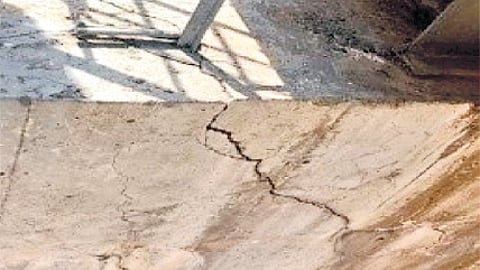

HYDERABAD: A report by a National Dam Safety Authority (NDSA) team that visited the Nagarjuna Sagar Project (NSP) in February this year said that the cracks in the NSP piers should be mapped thoroughly and closely monitored for further analysis and investigation.
The NDSA report highlighted, “Cracks were observed in the piers near the trunnion axis/counterweights in most of the piers, depicting similar patterns.” Furthermore, the NDSA observed that the reinforcement cover of the girder bridge is exposed at a few places near Spillway Gates No. 1 and 2. It recommended that minimum cover should be provided to the exposed reinforcement at the earliest. The report also emphasised the completion of all ongoing operations, maintenance works and repair works before the upcoming monsoon season.
During their inspection on February 13 and 14, the NDSA team also noted the erosion of the sill of ‘flip buckets’ at a few places on the downstream side of the spillway and suggested repairs during the lean season.
The inspection also covered the 815 MW powerhouse located on the left bank, under the control of TS Genco. Seepage was observed in the powerhouse complex from the upstream side of the dam, which was not being measured.
Similarly, seepage was observed in the 50MW right bank powerhouse, which is under the control of AP Genco, without any measurement being done. The NDSA report recommended the installation of seepage measuring devices at both powerhouses.
The NDSA said a comprehensive dam safety evaluation must be conducted in accordance with the provisions of the Dam Safety Act, 2021.
The drains on the downstream side of the earthen embankment should undergo thorough cleaning to remove any grass or congestion, ensuring clear and unobstructed drainage is essential for preventing waterlogging and potential structural issues. Collaboration among all Krishna basin states is imperative to effectively implement this strategy, the report said.
The project authorities are facing obstacles in regular operation and maintenance matters due to procedural delays. Currently, they are required to seek approvals and permissions from KRMB/security agencies before commencing O&M works.
These delays are hampering the smooth execution of O&M activities, which are vital for maintaining the safety and functionality of the dam and its associated structures. Streamlining the clearance process is crucial to ensure that O&M works are carried out promptly and without hindrances, the NDSA said.
The report said that the earthen portion of the dam and rip rap were found to be in satisfactory condition.